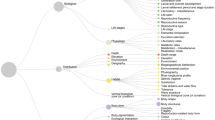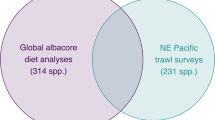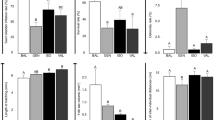Abstract
Functional traits can be valuable pieces of information for aquaculture research and management. Although fish traits have been the focus of an abundant research, trait datasets for these organisms are difficult to access and often unpractical to achieve meta-analyses without a time-consuming extensive review. Already available large-scale compilations include trait information for many fish species but not as detailed as required for aquaculture purpose. Here, we introduce the TOFF (i.e. Traits OF Fish), a database focusing on fish functional traits that aims at bringing together behavioral, morphological, phenological, and physiological traits always coupled to environmental measurement context into a single open-source access repository. TOFF hosts data from published field and experimental studies. Here, we release data for 228 traits for 174 species extracted from 165 publications and present a collaborative platform. We ultimately aim at providing an inclusive and accessible data resource to facilitate advances in aquaculture development.
Measurement(s) | behavior • morphology • phenological trait • physiological trait |
Technology Type(s) | digital curation |
Factor Type(s) | taxonomy • ploidy level • sex • developmental stage |
Sample Characteristic - Organism | Myxiniformes • Hyperoartia • Holocephali • Elasmobranchii • Sarcopterygii • Actinopterygii |
Machine-accessible metadata file describing the reported data: https://doi.org/10.6084/m9.figshare.10276040
Similar content being viewed by others
Background & Summary
Aquaculture is the farming of aquatic organisms in coastal or inland areas involving human control over the rearing/breeding process to enhance production1,2. Capture stagnation in wild fisheries and overexploitation of popular consumed species along with an increasing human demand for aquatic products have triggered an unprecedented development of aquaculture since the 1960s1,2,3. Nowadays, aquaculture provides about 50% of the world’s aquatic food consumption and still continues its exponential growth4. The worsening biodiversity crisis of aquatic species (e.g., for fishes5,6) and international organization recommendations (e.g.,7) are further encouraging aquaculturists to diversify their species production. However, producing new species is challenging because it requires to rear/breed organisms in an optimal way (e.g., efficient feeding practices, cost-effective captive environment) in human-controlled environment (e.g., ponds, netted cages, or re-circulated aquaculture systems in monoculture or polyculture context)2 on a long-term basis despite potential disturbances (e.g., climate change7). This challenge cannot be achieved without detailed knowledge of species biology and ecology2.
Functional traits are any phenotypic characteristic of individual organisms that impacts (in)directly the fitness of such organisms8 and is relevant to their effects on ecosystem properties9. These traits include behavioral, morphological, phenological, and physiological traits (BMPP traits) important to know how organisms interact with their environment and with other species8,10. Although this paradigm has not been widely applied to agricultural research and management, the functional trait approach can be applied to agro(eco)systems by understanding the role of agrobiodiversity (i.e. species composition and structure) in ecosystem processes and services11,12. This allows understanding or predicting interactions and fitness of species in a farmed environment to ultimately enhance the efficiency and sustainability of agriculture12, including aquaculture13. For instance, estimating feasibility and efficiency of new species combination by functional trait-based approach is a useful tool to promote polyculture practices which aim at culturing species displaying complementary resource uses (i.e. minimizing aquafarming environmental impact and maximizing production profitability) and minimal resource competition (see polyculture advantages in14). Similarly, functional trait analyses allow projecting the consequences of cultured environment modifications such as those triggered by climate changes on species production. Therefore, functional trait-based approach can limit time and money-consuming trial-and-error bioassays to assess alternative aquaculture development scenarios. This places a premium on the compilation of species trait datasets with broad taxonomic coverage in species groups significant for aquaculture, such as fishes, to foster applied developments through big data-based meta-analyses.
For more than a century, an abundant research has extensively studied the fish traits for a variety of purposes. This means that sufficient data might well already exist for addressing alternative development hypotheses and meta-analyses about fish aquaculture. However, an overview of broad-scale insights is poorly available because useful datasets are scattered over several decades of literature in many languages. Some trait compilations have already been proposed (e.g.,15,16,17,18) but most of them focus on particular set of traits to address specific questions, fail to ensure homogeneity of data (e.g., no standardized definitions of traits making comparison from different sources doubtful), gather information for a limited geographic area/taxonomic range, and/or has restricted availability. Although original citations are provided, the largest available comprehensive compilations of fish traits (i.e. FishBase [www.fishbase.org] or19) tend to provide only a synthesized mixture of original and meta-analysis datasets. Furthermore, the lack of important contextual information about measurement environmental context or levels of variation and replication for trait data limits such compilations. Yet, functional traits are environment-dependent20 and display variability at the interpopulational level21. Therefore, a database hosting detailed information about functional traits and their environmental measurement context, which are required for aquaculture purpose, is still lacking.
Here, we introduce TOFF (i.e. Traits OF Fish) database, the first curated collaborative database of functional trait information for fish species significant for aquaculture (i.e. seawater, brackish, and freshwater species). The aims of the database are: (i) to gather disparate information on fish traits associated with information about measurement environmental context, (ii) to provide unrestricted open-source access to fish trait data, and (iii) to engage the fish research community in the collection and quality control of trait datasets. We selected 228 validated, defined, and referenced BMPP traits with their measurement environmental context (i.e. 108 environmental features). The database can be fed, consulted, and modified by the fish research/aquaculture community through an online system archiving and presenting fish trait data for future research. We ultimately aim at providing an inclusive and accessible data resource to facilitate new advances in aquaculture.
Methods
TOFF focuses on functional traits of fish (sensu all taxa included in Myxini [hagfishes], Cephalaspidomorphi [lampreys], Holocephali [chimaeras], Elasmobranchii [sharks and rays], Sarcopterygii [lobe-finned fishes], and Actinopterygii [ray-finned fishes]), the most taxonomically diversified group among chordates with more than 34,000 species (according to FishBase [www.fishbase.org]). The database can host various types of data from multiple sources of literature (i.e. peer-reviewed articles, theses, monographs, and books). It has been designed to contain “records” that are information about BMPP traits for a fish species, at a specified developmental stage (i.e. larvae, juvenile, or adult), sex, and ploidy level in a characterized environment from a scientific source. This means that a study considering, for instance, different environments and/or developmental stages, sexes, and ploidy level is encoded as several records in the database. A record can be based on individual or group measurements from field observations or ex-situ experiments.
Database description
Considering the heterogeneous formats and contents of data referring to BMPP traits and environment measurements, we develop a flexible SQL relational database using EAV (entity - attribute - value) model coupled with controlled vocabularies. These latter ones are semantic tools, which consist of a list of terms, their definitions, and some of their properties such as their unit, their range (e.g., from 0 to 14 for pH), their spelling into drop-down menu (e.g., for categorical variables), or their format (see detailed thesaurus in22). Automatic controls are implemented in the database following the format, the spelling, and/or the range following thesaurus guidelines. TOFF uses postgreSQL as database management system. Each record in the database is unique, identifiable, checked by scientific expert board, and traceable. The database is hosted by the data center of the Institut national de la recherche agronomique (INRA) and baked up daily.
The relational database schema contains five core modules (Fig. 1, see detailed data model in22). First, the Reference module stores bibliographic metadata (e.g., authorship, publication type, publication year). Second, the Trait module integrates functional traits included in the database. These traits are grouped into four classes (i.e. behavioral, morphological, phenological, and physiological traits) and defined following the thesaurus22. Third, the Measure module includes each measure (i.e. attribute of a trait) of a particular trait. It is linked to the Trait module. The Measure module includes also information about the effective size (i.e. notifying on how many individuals is based the trait measure), the ploidy level (e.g., diploid or triploid fish), the development stage (i.e. larvae, juvenile, adult, or unknown), the sex (i.e. male, female, hermaphrodite, or unknown), the type of measure (i.e. detailing if the trait measure is based on a direct measurement, computed values, or predicted through modeling approach), and the name of measure recorder (i.e. the data contributor for a particular measure) associated to each measure. Fourth, the Environment module displays information about the environment in which the measures have been recorded. The environmental features are classified into three classes: abiotic environments (e.g., geographic occurrence, water parameters), biotic environment (e.g., population density, environment species diversity), and information about feeding (e.g., ad libitum). Fifth, the Species module (i.e. providing a table with the valid names of fish species based on FishBase species database (www.fishbase.org) extracted through the R-package rfishbase [current extraction date: January 2017]; this table is regularly updated to integrate taxonomic revision).
Overview of the design of the TOFF database. (a) General scheme of the database. (b) An example (from24) of a trait measure integrated in this scheme.
Data acquisition
All records in the TOFF database are extracted from (i) published resources including peer-reviewed articles, theses, monographs, and books or (ii) experimental studies (unpublished data). In the former case, the original source is always specified and must be provided by contributors. This allows performing meta-analyses citing all relevant references and integrating some or all type of published resources. Three types of data are recorded: continuous numerical values, discrete, or categorical data. Measurement value types include mean, standard deviation, median, maximum, minimum, and model derived. Continuous data are typically means extracted from tables or figures unless raw data are available. Aggregate values (e.g., means and medians) are always accompanied by the number of replicates and a measure of dispersion (e.g., standard deviation). The dataset here released have broad taxonomic range. However, some large data gaps exist because of the time-consuming review process required to feed the database. This places a premium on the swift development of a contributor community for TOFF to increase the dataset included in the database. In order to facilitate such a development, we propose an optimized importation tool from csv files to integrate large dataset in TOFF (see TOFF Assistant website: http://toff-project.univ-lorraine.fr).
Data Records
The thesaurus and detailed data model of TOFF are provided on figshare22 as a xlsx file and a pdf file, respectively. The current static release of TOFF contains 5143 records informing on 228 BMPP traits for 174 species from 165 references. The first steps of encoding work have focused on species with economical interest for freshwater aquaculture and their secondary/subordinate taxa. The static release as two csv files is available on figshare23. Details and references were produced with the R-script file provided on figshare23. Up-to-date database can be downloaded directly from this R-script file.
Technical Validation
TOFF is managed on a voluntary basis by an editorial board and database administrators. We develop a four-stage quality control of data and managing procedure. First, people willing (i.e. new contributor access) to be database contributors (or to be member of editorial board) must notify their demand to the editorial board through the TOFF website (http://toff-project.univ-lorraine.fr). They will receive an account and an access to the database through on-line system. Second, new data added by database contributors are not directly integrated to the main database but store in temporary repository. The integration of such new data in TOFF requires a prerequisite assessment by the editorial board (i.e. editor approval). Third, data issues noted by users can be reported to the editorial board through the TOFF website (i.e. user feedback). Fourth, in order to avoid duplicate, measurements with the same value, reference, location, and species will be automatically detected during the integration of database contributors to the main database.
Further developments
Currently, TOFF contains traits of only a fraction of fish species (e.g., lacking marine species) compare to the large number of species and thus some taxonomic classes are completely absent. Indeed, developing an extensive database is a long and challenging endeavor difficult for only few researchers. Therefore, TOFF is designed as a collaborative platform to integrate a large group of researchers worldwide in TOFF further developments. This means that the taxonomic coverages, the functional trait list, the relevant environmental descriptors, and the editor board will evolve over time thanks to contributions of interested researchers.
References
Food and Agriculture Organization of the United Nations. The State of World Fisheries and Aquaculture 2018 - Meeting the sustainable development goals. (Food and Agriculture Organization of the United Nations, 2018).
Teletchea, F. & Fontaine, P. Levels of domestication in fish: implications for the sustainable future of aquaculture. Fish Fish. 15, 181–195 (2014).
Ahmed, N. & Thompson, S. The blue dimensions of aquaculture: A global synthesis. Sci. Total Environ. 652, 851–861 (2019).
Food and Agriculture Organization of the United Nations. The State of World Fisheries and Aquaculture 2016. Contributing to food security and nutrition for all. (Food and Agriculture Organization of the United Nations, 2016).
Dudgeon, D. et al. Freshwater biodiversity: importance, threats, status and conservation challenges. Biol. Rev. Camb. Philos. Soc. 81, 163–82 (2006).
Nieto, A. et al. European Red List of marine fishes. (Publications Office of the European Union, 2015).
Food and Agriculture Organization of the United Nations. Planning for aquaculture diversification: the importance of climate change and other drivers. (Food and Agriculture Organization of the United Nations, 2017).
Violle, C. et al. Let the concept of trait be functional! Oikos 116, 882–892 (2007).
Díaz, S. et al. Functional traits, the phylogeny of function, and ecosystem service vulnerability. Ecol. Evol. 3, 2958–2975 (2013).
Dı́az, S. & Cabido, M. Vive la différence: plant functional diversity matters to ecosystem processes. Trends Ecol. Evol. 16, 646–655 (2001).
Wood, S. A. et al. Functional traits in agriculture: agrobiodiversity and ecosystem services. Trends Ecol. Evol. 30, 531–9 (2015).
Martin, A. R. & Isaac, M. E. Plant functional traits in agroecosystems: a blueprint for research. J. Appl. Ecol. 52, 1425–1435 (2015).
Costa-Pierce, B. A. In Sustainable Food Production. Springer (eds. Christou, P., Savin, R., Costa-Pierce, B. A., Misztal, I. & Whitelaw, C. B. A.) 174–183 (Springer New York, 2013).
Stickney, R. R. In Sustainable Food Production (eds. Christou, P., Savin, R., Costa-Pierce, B. A., Misztal, I. & Whitelaw, C. B. A.) 1366–1368 (Springer New York, 2013).
Teletchea, F. et al. STOREFISH: A new database dedicated to the reproduction of temperate freshwater teleost fishes. Cybium 31, 227–235 (2007).
Blanck, A. & Lamouroux, N. Large-scale intraspecific variation in life-history traits of European freshwater fish. J. Biogeogr. 34, 862–875 (2007).
Mims, M. C., Olden, J. D., Shattuck, Z. R. & Poff, N. L. Life history trait diversity of native freshwater fishes in North America. Ecol. Freshw. Fish 19, 390–400 (2010).
Côte, J., Kuczynski, L. & Grenouillet, G. Spatial patterns and determinants of trait dispersion in freshwater fish assemblages across. Europe. Glob. Ecol. Biogeogr. 28, 826–838 (2019).
Frimpong, E. A. & Angermeier, P. L. Fish Traits: A Database of Ecological and Life-history Traits of Freshwater Fishes of the United States. Fisheries 34, 487–495 (2009).
Ghalambor, C. K., Mckay, J. K., Carroll, S. P. & Reznick, D. N. Adaptive versus non-adaptive phenotypic plasticity and the potential for contemporary adaptation in new environments. Funct. Ecol. 21, 394–407 (2007).
Alofs, K. M. The influence of variability in species trait data on community-level ecological prediction and inference. Ecol. Evol. 6, 6345–6353 (2016).
Lecocq, T. et al. Thesaurus and database model of TOFF. figshare, https://doi.org/10.6084/m9.figshare.10253219.v4 (2019).
Lecocq, T. et al. TOFF Data Release. figshare, https://doi.org/10.6084/m9.figshare.10253291.v2 (2019).
Vanina, T. et al. Genetic and aquaculture performance differentiation among wild allopatric populations of European perch (Percidae, Perca fluviatilis). Aquaculture 503, 139–145 (2019).
Acknowledgements
The authors would like to thank INRA Metaprogram EcoSerV2 for financial support.
Author information
Authors and Affiliations
Contributions
T.L., A.B., A.P., and M.T. conceived the idea. A.B. and A.D. developed the database structure. A.B. and K.D.-M. developed the importation assistant. T.L., A.B., S.N., I.L., and M.T. compiled the preliminary data. All authors compiled, entered, and edited trait data and jointly wrote the article.
Corresponding author
Ethics declarations
Competing interests
The authors declare no competing interests.
Additional information
Publisher’s note Springer Nature remains neutral with regard to jurisdictional claims in published maps and institutional affiliations.
Rights and permissions
Open Access This article is licensed under a Creative Commons Attribution 4.0 International License, which permits use, sharing, adaptation, distribution and reproduction in any medium or format, as long as you give appropriate credit to the original author(s) and the source, provide a link to the Creative Commons license, and indicate if changes were made. The images or other third party material in this article are included in the article’s Creative Commons license, unless indicated otherwise in a credit line to the material. If material is not included in the article’s Creative Commons license and your intended use is not permitted by statutory regulation or exceeds the permitted use, you will need to obtain permission directly from the copyright holder. To view a copy of this license, visit http://creativecommons.org/licenses/by/4.0/.
The Creative Commons Public Domain Dedication waiver http://creativecommons.org/publicdomain/zero/1.0/ applies to the metadata files associated with this article.
About this article
Cite this article
Lecocq, T., Benard, A., Pasquet, A. et al. TOFF, a database of traits of fish to promote advances in fish aquaculture. Sci Data 6, 301 (2019). https://doi.org/10.1038/s41597-019-0307-z
Received:
Accepted:
Published:
DOI: https://doi.org/10.1038/s41597-019-0307-z
This article is cited by
-
A roadmap to define and select aquatic biological traits at different scales of analysis
Scientific Reports (2023)
-
How do fish functional traits respond to dams at the global scale?
Hydrobiologia (2023)
-
A trait database and updated checklist for European subterranean spiders
Scientific Data (2022)
-
Phenotyping in the era of genomics: MaTrics—a digital character matrix to document mammalian phenotypic traits
Mammalian Biology (2022)




